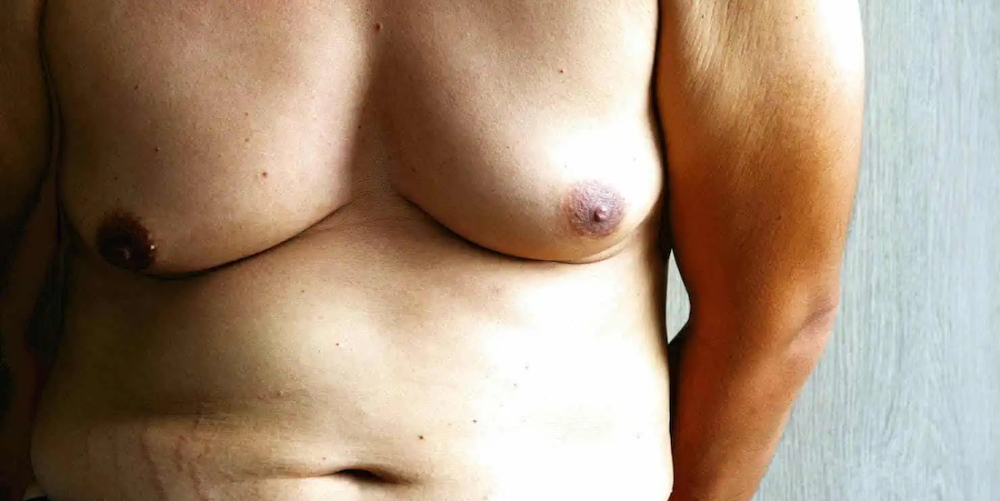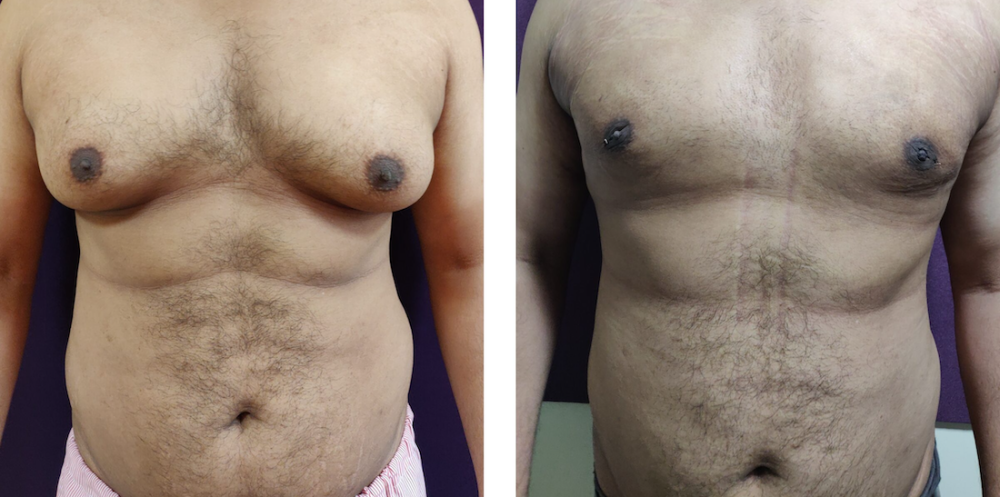
As medical science reveals more about male breast tissue enlargement — Gynecomastia — fashion industries worldwide develop innovative solutions for those experiencing this common condition.

New York, N.Y. — The colloquial term “man boobs” masks a complex medical condition affecting millions worldwide. Gynecomastia, the clinical designation for benign proliferation of glandular tissue in the male breast, represents far more than an aesthetic concern—it encompasses significant psychological distress, evolving treatment protocols, and an emerging fashion industry dedicated to addressing the needs of those experiencing this condition.
Medical Foundations and Health Implications
Gynecomastia affects over 50% of individuals at some point during their lives, making it remarkably common despite limited public discourse. The condition results from hormonal imbalances, specifically involving testosterone and estrogen, though distinguishing between true gynecomastia and pseudogynecomastia—breast enlargement due to fatty tissue deposits—remains critical for appropriate treatment.
The condition exhibits a trimodal age distribution, with incidence peaking in newborns (60-90%), adolescents (4-69%), and men over 50 years (24-65%). These wide prevalence ranges reflect varying diagnostic criteria and population characteristics across studies. Recent research from Israel examining over 530,000 adolescents found actual incidence rates of just 1.08%, considerably lower than historical estimates, suggesting previous studies may have significantly overestimated occurrence.
The health implications extend beyond physical manifestations. While gynecomastia poses no threat to physical health, it significantly impacts self-esteem and mental wellbeing. The condition carries significant psychological distress, social stigma, and dysphoria, particularly affecting adolescents navigating formative developmental periods.
Approximately 10-25% of cases result from medications or exogenous chemicals, including antipsychotics, antiretrovirals, and prostate cancer therapies. Environmental factors such as obesity, anabolic steroids, and chemicals mimicking estrogen in cosmetic products have been suggested as contributing to potentially rising prevalence.

Geographic Distribution and Global Patterns
Globally, gynecomastia affects 50-65% of males across all regions, though comprehensive epidemiological data remains limited. Denmark experienced a five-fold increase in incidence among 16-20-year-olds and greater than ten-fold increases across other age groups between 1998-2017, prompting questions about whether similar patterns exist worldwide.
Studies from Pakistan report overall incidence of 32-40%, with highest prevalence reaching 65% in older men. Israeli research revealed ethnic variations, with 1.28% prevalence among Jewish adolescents compared to 0.67% among Arab adolescents, though disparities diminished when controlling for socioeconomic status. These findings suggest complex interactions between genetic factors, environmental exposures, and socioeconomic conditions contribute to geographic variation.
Research examining hospitalized adult males aged 27-92 found 65% prevalence, with highest rates (72%) among 50-69-year-olds and strong correlation with body mass index. More than 80% of individuals with B.M.I. above 25 kg/m² (55 lbs/ft²) exhibited gynecomastia, underscoring obesity’s role in condition prevalence.
Historical Perspectives
Galen introduced the term gynecomastia in the second century A.D., defining it as unnatural increase in male breast fat, though he recognized glandular enlargement as a separate entity. The first recorded surgical treatment description came from Paulas of Aegina in the seventh century A.D., who termed the condition “effeminacy of men”.
Islamic physicians including Haly Abbas and Al-Zahrawi (Albucasis) described surgical management techniques based on Paulas’s work, with Al-Zahrawi’s methods practiced for centuries. In the 18th century, Olpan, Schuchardt, and Gruber worked on gynecomastia, though probable etiology remained undiscussed until much later.
While no direct evidence documents gynecomastia prevalence during the Continental Congress of 1776, the condition’s long-recognized existence—coupled with understanding of physiological factors including hormonal fluctuations, liver disease, and malnutrition—suggests it affected historical populations. However, period clothing styles, medical knowledge limitations, and social attitudes toward discussing male bodies mean historical prevalence remains largely undocumented.
Dr. Helen Ingleby published two documented gynecomastia cases in 1919, marking early 20th-century clinical recognition. Several medical and surgical treatments were described throughout the 1800s, with approaches continuing to evolve.
Fashion Industry Response
The fashion industry has developed specialized solutions addressing gynecomastia-related concerns, creating an entire subcategory of men’s shapewear and compression garments. These compression shirts provide immediate chest slimming appearance without losing binding effectiveness, designed to fit seamlessly under various clothing types.
Designs typically employ tight-fitting, high-elasticity fabrics such as spandex or elastane, providing uniform compression across the chest area while contouring the body naturally. Advanced designs include strategic support zones under arms and along sides, preventing shifting while maintaining effectiveness throughout the day.
Product categories include traditional compression vests extending to the waist, shorter chest-only coverage options, zippered vests allowing tailored fit adjustment, and chest binders with multiple clasp designs offering varying compression levels. Material selection focuses on breathability, with moisture-wicking fabrics, microfiber, and cotton preferred over sweaty polyester, though garments should not be worn exceeding eight hours daily.
Beyond specialized undergarments, general styling strategies include selecting shirts with chest pockets creating visual disruption, wearing well-fitted jackets that obscure chest contours, choosing graphic prints providing stiffness across chest areas, and employing darker colors with structured materials.
The market encompasses multiple manufacturers worldwide, from North American companies to suppliers across Europe, Asia, and other regions. Pricing ranges from US$20-30 (€18-28, ¥2,800-4,200) for basic models to premium options exceeding US$100 (€93, ¥14,000). These solutions offer alternatives to expensive surgical intervention, which remains the only permanent correction for true glandular gynecomastia.
Treatment Approaches and Outcomes
For adolescents, physiological gynecomastia resolves spontaneously in 75-90% of cases within 1-3 years as puberty progresses and testosterone levels increase. By age 17, only 10% of adolescent males retain persistent gynecomastia.
Medical therapy proves most effective during acute phases when breast tissue remains tender and present less than six months. Tamoxifen demonstrates best evidence for treating acute, idiopathic gynecomastia. However, medications become less effective after tissue scarring occurs following twelve months, and no drugs have received F.D.A. approval specifically for gynecomastia treatment.
Contemporary surgical approaches employ multifaceted techniques, removing fatty components through liposuction variants while directly excising glandular tissue, then redraping or resecting skin in severe cases. Surgery remains reserved for cases involving significant psychological distress, persistent enlargement after observation periods, or when medical therapy proves ineffective.

Societal Implications and Future Directions
Among 237 adult cases examined, 62.8% presented with aesthetic concerns and 51.2% reported breast pain, with 45.1% classified as idiopathic despite comprehensive evaluation. These statistics underscore both the condition’s prevalence and diagnostic challenges.
The intersection of medical understanding, psychological support, and fashion innovation continues evolving. As research illuminates epidemiological patterns and environmental contributors, while simultaneously the fashion industry develops increasingly sophisticated solutions, those experiencing gynecomastia gain access to comprehensive management strategies extending beyond surgical intervention alone.
Understanding gynecomastia requires recognizing it as a multifaceted condition intersecting medicine, psychology, fashion, and cultural attitudes toward male bodies—a reality affecting millions who deserve both clinical understanding and practical solutions supporting their wellbeing and confidence.
Summary
Gynecomastia, the enlargement of male breast tissue, affects over half of all individuals during their lifetime, peaking in newborns, adolescents, and older adults. While medically benign, it causes significant psychological distress and social stigma. The condition results from hormonal imbalances between testosterone and estrogen. Global prevalence ranges from 32-65%, with variations across regions and ethnic groups. The fashion industry has responded with specialized compression garments and styling strategies. Treatment options include observation, medication for acute cases, and surgical intervention for persistent conditions.
#Gynecomastia #MensHealth #MedicalCondition #HormoneHealth #MensFashion
#BodyImage #MensShapewear #HealthcareInnovation #MentalHealth #FashionTechnology
TAGS: gynecomastia, male breast enlargement, men’s health, hormonal imbalance, testosterone,compression shirts,
men’s shapewear, chest binders, pseudogynecomastia, body image, adolescent health, endocrine disorders, fashion industry,
estrogen, specialized clothing, medical textiles, surgical treatment, tamoxifen, mental health stigma, global health patterns
Social Media Posts
Facebook: Understanding Gynecomastia: More Than Just “Man Boobs”
Did you know that over 50% of individuals experience gynecomastia at some point in their lives? This medical condition involves hormonal imbalances affecting male breast tissue and carries significant psychological implications.
From medical treatments to innovative fashion solutions, learn about the comprehensive approaches helping millions worldwide manage this common condition. The article explores global prevalence patterns, historical context, health implications, and how the specialized clothing industry provides alternatives to surgical intervention.
Read the full feature to understand the intersection of medicine, psychology, and fashion innovation addressing this often-misunderstood condition.
Instagram: Gynecomastia affects 50-65% of males globally, yet remains surrounded by stigma and misunderstanding. This benign breast tissue enlargement results from hormonal imbalances and peaks during three life stages: infancy, adolescence, and older adulthood.
Beyond medical treatments, the fashion industry has developed specialized compression garments and styling strategies offering practical daily solutions. From understanding causes to exploring treatment options, comprehensive approaches support both physical and psychological wellbeing.
LinkedIn: New Research Illuminates Gynecomastia’s Global Impact and Industry Response
Clinical analysis reveals gynecomastia affects 50-65% of males worldwide, with significant variations across regions and age groups. Recent epidemiological studies from Denmark document dramatic incidence increases, while Israeli research examining 530,000 adolescents provides unprecedented baseline data.
The condition’s psychological implications—particularly during adolescent development—underscore the importance of comprehensive management strategies. Medical interventions range from hormonal therapy to surgical correction, while the fashion industry has developed a specialized sector producing compression garments and styling solutions.
This intersection of healthcare, psychology, and fashion innovation demonstrates how industries adapt to address significant but often overlooked health conditions affecting millions globally.
X / Twitter: Gynecomastia affects 50-65% of males globally—far more common than most realize. From hormonal causes to fashion industry solutions, understanding this condition requires recognizing its medical, psychological, and social dimensions. Comprehensive care means addressing both health and wellbeing.
BlueSky: Over 50% of individuals experience gynecomastia during their lifetime, yet stigma persists. This hormonal condition affecting male breast tissue peaks during infancy, adolescence, and older adulthood. Modern approaches combine medical treatment, psychological support, and innovative fashion solutions providing alternatives to surgery. Understanding the intersection of health science and practical solutions helps millions manage this common but often misunderstood condition.